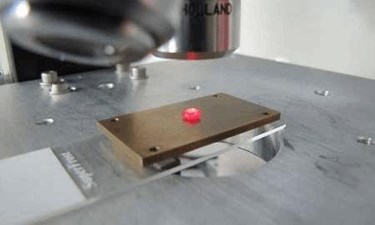New Quantum States For Better Quantum Storage

How can you store quantum information as long as possible? A team from the Vienna University of Technology is making an important step forward in the development of quantum storage.
The memory that we use today for our computers differs only between 0 and 1. However, quantum physics also allows arbitrary superimpositions of states. On this principle, the "superposition principle", ideas for new quantum technologies are based. A key problem, however, is that such quantum-physical overlays are very short-lived. Only a tiny amount of time you can read the information from a quantum memory reliably, then it is irretrievably lost.
At the TU Vienna is an important step forward has now succeeded in developing new quantum memory concepts. In collaboration with the Japanese telecommunication giant NTT, the Viennese researchers, under the direction of Johannes Majer, are working on quantum storage of nitrogen atoms and microwaves. Due to their different environment, the nitrogen atoms have all slightly different properties, as a result of which the quantum state "ruptures" relatively quickly.However, by specifically manipulating a small part of the atoms, it is possible to bring them into a new quantum state, which has a lifetime which is more than tenfold. These results have now been published in the journal "Nature Photonics".
Nitrogen in diamond
"We use synthetic diamonds, in which individual nitrogen atoms are incorporated." Explains project leader Johannes Majer from the Atomic Institute of the Vienna University of Technology. "The quantum state of these nitrogen atoms are pieced together with microwave, which gives a quantum system in which we store information and can read again later. "
the storage period in these systems is, however, limited in the nitrogen atoms in the diamond crystal by the inhomogeneous broadening of the microwave transitions. After about half a microsecond, the quantum state can no longer be reliably read out, the actual signal is lost. The team led by Johannes Majer now had the idea of "spectral hole burning", a trick that allows it in the optical domain to store data in inhomogeneously broadened media, adapting them for superconducting quantum circuits and spin quantum memory.
Dmitry Crimean, Beneditk Hartl and Stefan Rotter (Institute of Theoretical Physics, TU Vienna) could in theory work show that those states which are largely decoupled from the disturbing noise also exist for these systems. "the trick is to bring the quantum system by targeted manipulation in these long-lived states, so that the information can also there are stored " explains Dmitry Crimean.
Certain energy rule
" by the local properties of the less than perfect diamond crystal has the transitions in the nitrogen atoms slightly different energies ", explains Stefan Putz, first author of the study, in the meantime from the Vienna University of Technology To Princeton University, where a "spectral hole" is created by the use of microwaves to selectively "purge" nitrogen atoms at a certain energy. The remaining nitrogen atoms can then be brought into a new quantum state, a so-called dark state, at the center of this "spectral hole". This is much more stable and opens up new possibilities. "Our work is a proof of concept for a new concept with which we want to lay the foundation for the further exploration of innovative surgical protocols of quantum memories", says Stefan Putz.
With the new method the lifetime of quantum states could Of the coupled system of microwaves and nitrogen atoms are increased by more than ten times to about five microseconds. This is in the timescale of our daily life is still not much, but enough for important quantum technological applications of this. "The advantage of our system is that you can write quantum information within nanoseconds and read", explains Johannes Majer. "In the microseconds it can be kept stable, therefore a large number of operations is possible ".
About Quantum Physics and Quantum Technologies
Quantum Physics and Quantum Technologies is one of five research foci at the Vienna University of Technology, in addition to Computational Science & Engineering, Materials & Matter, Information & Communication Technology and Energy & Environment.Potential applications of quantum phenomena are investigated. These range from fundamental interactions of the elementary particles via radiation sources for ultrasound photon pulses to the control of the states of individual atoms and thus to components for the quantum computer.
Source: TU Wien
